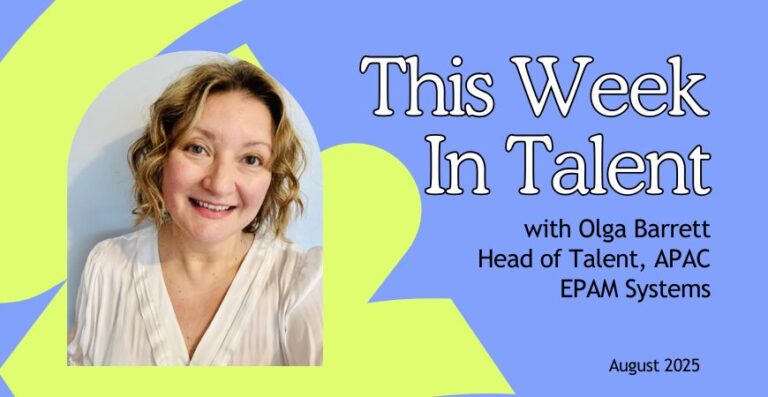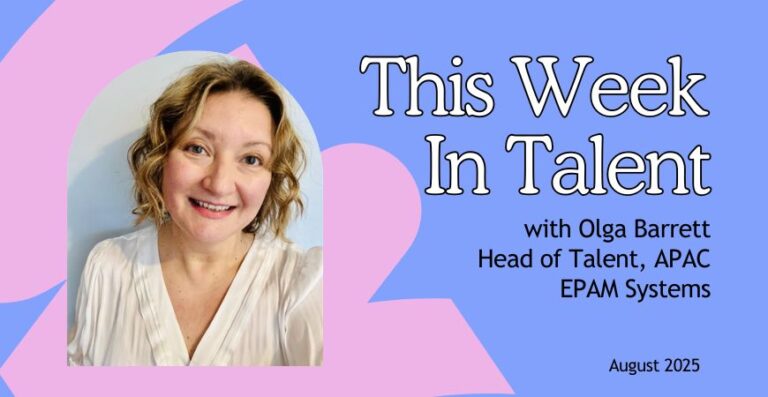Career Moves: From Talent Acquisition to Labour Procurement to Culture Uplift
The Plan (That Didn’t Happen)
Back in school, I had a clear plan: share-house with some girlfriends, study Law and French, then become a diplomat in a chic French-speaking country. Très bien, right? But life had other plans. I fell in love, dropped out of Law, and got a crash course in “how to adult.”
Falling Into Recruitment (didn’t we all?)
Landing my first recruitment job at Hudson felt huge – my first ‘real’ job. I spent too much money on Cue suits, grabbed my compendium, and hit the streets recruiting for office support temps in the industrial sector.
I loved it – learning about how business worked, what people wanted from their contractors and contracts, and how recruitment actually worked. I was filling roles and smashing budget, but those cold sales calls? Rough. So, when an internal role at EnergyAustralia came up, I jumped. That leap turned into a long ride – leading TA through acquisitions, divestments, rebrands, leadership shakeups, audits, governance challenges, the ‘war for talent,’ and the Global Financial Crisis. I worked with fabulous leaders and people, but all good things must come to an end. When that chapter closed, I had no idea what was next, but I figured some time at an RPO would round out my expertise.
Enter: my relentless pursuit of Korn Ferry. Thankfully, after relentless pursuit they finally said yes. It was another amazing experience – and it gave me the confidence to challenge myself again. A special stint at deliberate practice deepening my HR market knowledge, recruiting, career coaching and helping others reminded me what I was capable of, so I shifted into Executive Search with Alex Kaar. A fancy Collins St office, high-profile clients, high-performing team. I was going to be the best HR recruiter this city had ever seen! But the pull back to internal was just too strong when Medibank came knocking.
Life Happens (Again)
While on secondment from Alex Kaar to Medibank, in the midst of working on a massive job list, I discovered I was pregnant, and decided to accept the offer of a permanent role at Medibank. The culture, work-life balance, support, a genuine D&I commitment, and the people – how could I say no? It seemed like the right time to put down roots.
Returning from parental leave, I took on the Contingent Workforce Lead role. Still TA-adjacent but now focused on building a system that improved risk, cost, and experience. Turns out, I loved this kind of work. The Contingent Workforce space is one that is unique and exciting. There’s something about the pace, the balance of transactional and strategic thinking, the specific and often misunderstood risks, and the fact that it’s hard to do well, that made it a fascinating challenge for me. Helping people understand all the acronyms – T&M, SOW, ICs, plus MSPs, RPOs and VMS (often when they didn’t really care but needed to know so they could make the best choice for their situation). We had a great MSP in place but still had room to grow and improve, and I found the work incredibly satisfying.
The Pivot to Procurement
Thirteen years into recruitment (and maybe starting to grasp adulthood), I felt that itch. What next?
I loved working with partners – MSPs, agencies, consultants. I had also worked closely with Procurement teams at both EnergyAustralia and Medibank. Let’s face it, Labour spend is the largest expense any organisation has so when you’re managing a Contingent Workforce, a solid partnership with your Procurement Leader is mission critical. I’m a bit of a nerd for the numbers and strangely the contract side of things too so I pitched a move into Procurement. With a great boss backing me (and more persistence than I care to admit), our Procurement Leader gave me a shot. Procurement felt like recruitment on acid – still following a process (brief, source, assess, award, manage) but on a different scale. Big business problems, solved by bringing in the right people, technology, and processes. What a learning curve!
As I was finding my rhythm, baby #2 arrived and while on parental leave, I was asked to join a new function – Customer Trust. Could I help restore and maintain customer trust after a high-profile incident? Again, how could I say no?
So Here I Am…
Today, I work at the intersection of risk, governance, and culture. My experience has helped me establish myself in this role, collaborating with guardrails functions and the end-users of those guardrails to ensure we go above and beyond our obligations. And while I’m not done with this, I do sometimes wonder what’s next? Based on my career path so far – who knows?!
What I’ve Learned Along the Way
I learned from everyone.
- Recruiters and suppliers (who know more about business and people than they get credit for).
- The great leaders – and the not-so-great ones.
- Every single mistake I’ve made.
- The wins that reminded me I’m on the right track.
- How to put myself out there and get back up when I fall.
Lessons that shaped me:
✔ Keep going – even when it’s messy.
✔ Reflect, but don’t obsess.
✔ Be curious and compassionate. Everyone is going through something. Get results, but don’t crash through people to get them.
✔ My way isn’t always the best way.
✔ Keep learning. When work doesn’t feel as challenging as it could, find something new to learn. Join D&I groups, work on the RAP, say yes to speaking engagements.
For me, career success isn’t about titles – it’s about growth. These lessons haven’t just made me better at work. They’ve made me a better human.
The Parts You Don’t See
This story doesn’t include the jobs I didn’t get.
❌ The roles I was headhunted for – then missed out on.
❌ The roles I chased and didn’t land.
❌ The internal promotions I thought were a sure thing – but weren’t.
❌ The tears over performance reviews downgraded by the bell curve.
That stuff taught me a lot too. And honestly? I’m just as grateful for it as I am for the wins.
Final Thought
I didn’t become a diplomat in Paris, but I’ve built a career full of purpose, alongside a bunch of amazing people. I love bringing people together to solve complex problems and if I squint my eyes and play a French song, it’s just like being a Diplomat in Paris.







